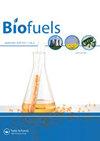纳米颗粒悬浮生物柴油及其在压缩点火发动机中的混合物:研究趋势和未来展望的文献计量学分析
IF 2.6
4区 工程技术
Q3 ENERGY & FUELS
引用次数: 2
摘要
摘要介绍了纳米颗粒悬浮生物柴油发动机性能研究的文献计量学分析。使用VOS查看器®分析了2009年至2021年从Scopus®数据库中提取的NSBEPR出版数据。分析了参与国家和组织的合著者网络、科学论文和期刊的引用次数以及作者关键词的共现情况,以研究研究趋势、热点、时间分布和未来方向。本研究共使用了260篇科学出版物,网络分析显示,印度(208篇文章,4514次引用)和马来亚大学(12篇文章,700次引用)分别是NSBEPR方面最有成效的国家和机构。被引用最多的论文和期刊是Shaafi和Velraj(2015)的作品以及《燃料》,分别被引用208次和1256次。利用金属氧化物(Al2O3和CeO2)作为纳米颗粒,利用废弃(食用油)和食用(大豆油)作为生物柴油原料,利用生物柴油与柴油(20%)混合作为燃料,以及在直燃式柴油发动机中的研究是研究热点。未来的研究重点是部署磁性调理、绿色和新型纳米颗粒、混合和新型生物柴油、氢气、废轮胎和塑料油作为燃料添加剂。本文章由计算机程序翻译,如有差异,请以英文原文为准。
Nanoparticles-suspended biodiesel and its blends in compression ignition engines: a bibliometric analysis of research trend and future outlook
Abstract The bibliometric analysis of nanoparticle-suspended biodiesel engine performance research (NSBEPR) has been presented. Publication data on NSBEPR extracted from the Scopus® database from 2009 to 2021 were analyzed using VOS viewer®. The network of co-authorship of participating countries and organizations, citation counts of scientific papers and journals, and co-occurrence of author keyword were analyzed to study the research trend, hotspot, temporal distribution, and future direction. With a sum of 260 scientific publications used in this study, the network analysis revealed India (208 articles and 4514 citations) and the University of Malaya (12 articles and 700 citations) were the most productive country and institution, respectively, concerning NSBEPR. The most cited paper and journal were the work of Shaafi and Velraj (2015) and “Fuel” with 208 and 1256 citations, respectively. The utilization of metal oxides (Al2O3 and CeO2) as nanoparticles, waste (cooking oil) and edible (soybean) oils as biodiesel feedstocks, biodiesel blend with diesel (at 20%) as fuel, and the investigation of the same in direct ignition diesel engines were observed as the research hotspots. Future research focused on the deployment of magnetic conditioning, green and novel nanoparticles, hybrid and novel biodiesel, hydrogen, spent tire, and plastic oils as fuel additives.
求助全文
通过发布文献求助,成功后即可免费获取论文全文。
去求助
来源期刊

Biofuels-Uk
Energy-Renewable Energy, Sustainability and the Environment
CiteScore
5.40
自引率
9.50%
发文量
56
期刊介绍:
Current energy systems need a vast transformation to meet the key demands of the 21st century: reduced environmental impact, economic viability and efficiency. An essential part of this energy revolution is bioenergy.
The movement towards widespread implementation of first generation biofuels is still in its infancy, requiring continued evaluation and improvement to be fully realised. Problems with current bioenergy strategies, for example competition over land use for food crops, do not yet have satisfactory solutions. The second generation of biofuels, based around cellulosic ethanol, are now in development and are opening up new possibilities for future energy generation. Recent advances in genetics have pioneered research into designer fuels and sources such as algae have been revealed as untapped bioenergy resources.
As global energy requirements change and grow, it is crucial that all aspects of the bioenergy production process are streamlined and improved, from the design of more efficient biorefineries to research into biohydrogen as an energy carrier. Current energy infrastructures need to be adapted and changed to fulfil the promises of biomass for power generation.
Biofuels provides a forum for all stakeholders in the bioenergy sector, featuring review articles, original research, commentaries, news, research and development spotlights, interviews with key opinion leaders and much more, with a view to establishing an international community of bioenergy communication.
As biofuel research continues at an unprecedented rate, the development of new feedstocks and improvements in bioenergy production processes provide the key to the transformation of biomass into a global energy resource. With the twin threats of climate change and depleted fossil fuel reserves looming, it is vitally important that research communities are mobilized to fully realize the potential of bioenergy.
 求助内容:
求助内容: 应助结果提醒方式:
应助结果提醒方式:


